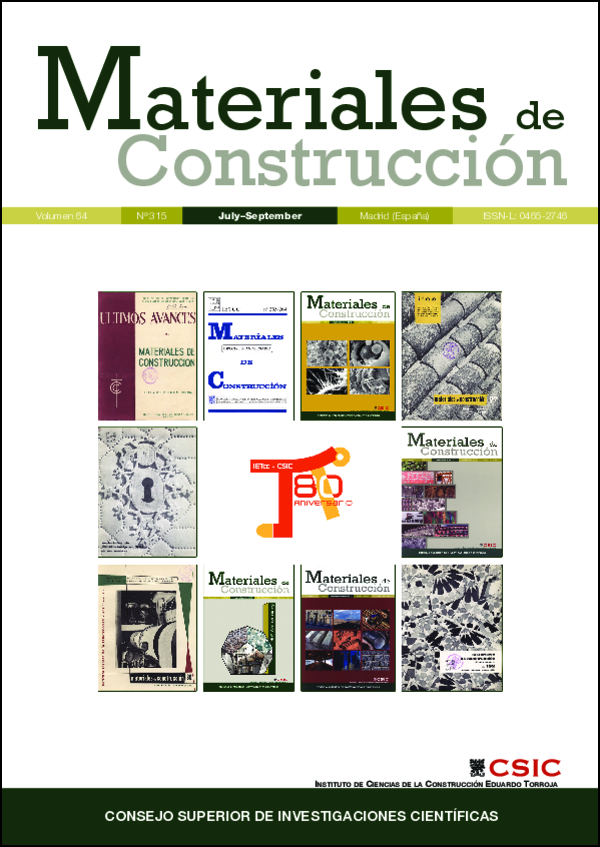Static and kinetic friction coefficients of Scots pine (Pinus sylvestris L.), parallel and perpendicular to grain direction
DOI:
https://doi.org/10.3989/mc.2014.03913Keywords:
Friction, Wood, Physical propertiesAbstract
In this study the static (µe) and kinetic (µd) coefficients of friction were obtained for Pinus sylvestis L. sawn timber of Spanish origin. Friction between transverse surfaces sliding perpendicular to the grain (tangential direction) and radial surfaces sliding parallel to the grain was analyzed. A specifically designed device was used for tests, which makes it possible to apply contact pressure and measure displacements and applied loads simultaneously. Coefficients of friction between transverse surfaces (µe = 0,24; µd = 0,17) were about twice of the coefficients of friction between radial surfaces (µe = 0,12; µd = 0,08). Furthermore, these values are located within normal values of those commonly reported for softwood. The results are considered preliminary due to the small number of specimens.
Downloads
References
Villar, J.R.; Guaita, M.; Vidal, P.; Arriaga, F. (2007) Analysis of the stress state at the cogging joint in timber structures, Biosystems Engineering, n° 96 (1), pp. 79–90, http://dx.doi.org/10.1016/j.biosystemseng.2006.09.009
Soilán, S.; Arriaga, F.; Baño, V.; Crespo, J.; Guaita, M. (2011a) Análisis del comportamiento de la unión en cola de milano mediante simulación numérica por el método de los elementos finitos, CIMAD 11, 1° Congreso Ibero-Latino Americano de la madera en la construcción, Coimbra, Portugal.
Soilán, S.; Arriaga, F.; Guaita, M. (2011b) Análisis tensional mediante simulación numérica de la unión en cola de milano redondeada entre vigas y viguetas de madera, VI Congreso Ibérico de Agro-Engenharia, Evora-Portugal.
Aira, J.R.; Arriaga, F.; Íñiguez-González, G.; Guaita, M.; Esteban, M. (2012) Analysis of the stress state of a halved and tabled traditional timber scarf joint with the finite element method, WCTE2012, World Conference on Timber Engineering, Auckland, New Zealand.
Burbano, S.; Burbano, E.; García, C. (1993) Física General, p. 950, Mira editores, XXXI edición, Zaragoza, España.
Glass, S.V.; Zelinka, S.L. (2010) Chapter 4: Moisture Relations and Physical Properties of Wood, Wood Handbook, Forest Products Laboratory, Madison, USA.
Bejo, L.; Lang, E.M.; Fodor, T. (2000) Friction coefficients of wood-based structural composites, Forest Products Journal, vol. 50, n° 3, pp. 39–43.
Serway, R.A.; Jewett, J.W. (2003) Física, 3ª edición, volumen 1, Thomson Editores, Madrid, España.
Kollmann, F. (1959) Tecnología de la madera y sus aplicaciones (Technologie des Loses und der Holzwerkstoffe), Instituto Forestal de Investigaciones y Experiencias y el Servicio de la Madera, Tomo 1, Ministerio de Agricultura, Madrid.
UNE-EN 1995-2:2010 Eurocódigo 5: Proyecto de estructuras de madera, Parte 2: Puentes.
ASTM G115-10 Standard Guide for Measuring and Reporting Friction Coefficients.
Crespo, J.; Regueira, R.; Soilán, A.; Díez, M.R.; Guaita, M. (2011) Desarrollo de metodología para la determinación de los coeficientes de fricción estático y dinámico de diferentes especies de madera, CIMAD 11, 1° Congreso Ibero-Latino Americano de la madera en la construcción, Coimbra, Portugal.
UNE-EN 408 Estructuras de madera, Madera aserrada y madera laminada encolada para uso estructural, Determinación de algunas propiedades físicas y mecánicas.
UNE-EN 13183-1 Contenido de humedad de una pieza de madera aserrada, Parte 1: Determinación por el método de secado en estufa.
Published
How to Cite
Issue
Section
License
Copyright (c) 2014 Consejo Superior de Investigaciones Científicas (CSIC)

This work is licensed under a Creative Commons Attribution 4.0 International License.
© CSIC. Manuscripts published in both the printed and online versions of this Journal are the property of Consejo Superior de Investigaciones Científicas, and quoting this source is a requirement for any partial or full reproduction.All contents of this electronic edition, except where otherwise noted, are distributed under a “Creative Commons Attribution 4.0 International” (CC BY 4.0) License. You may read here the basic information and the legal text of the license. The indication of the CC BY 4.0 License must be expressly stated in this way when necessary.
Self-archiving in repositories, personal webpages or similar, of any version other than the published by the Editor, is not allowed.


















